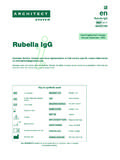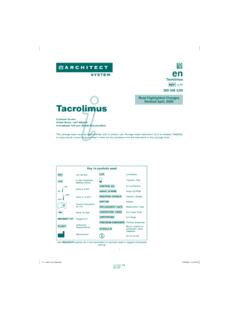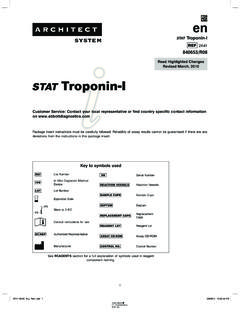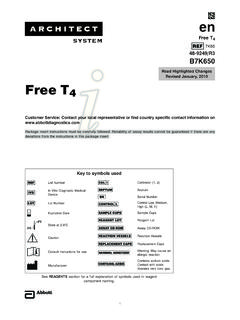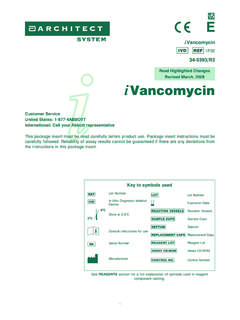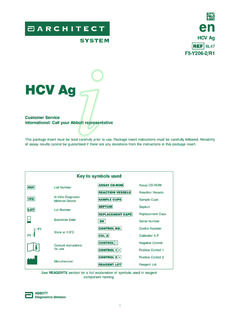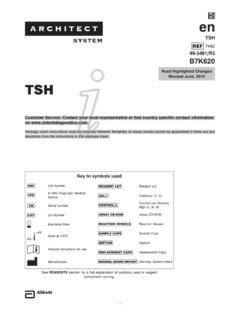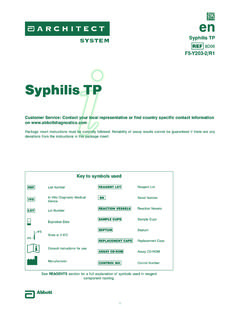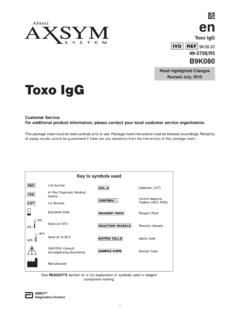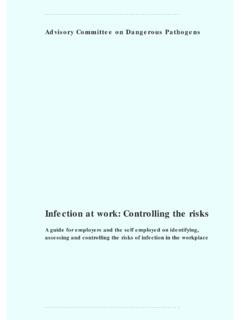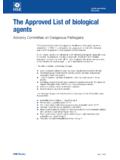Transcription of Trig A R3 - Ilex Medical Ltd.
1 1 TRIGLYCERIDEThis package insert contains information to run the Triglyceride assay on the ARCHITECT c Systems and the AEROSET : Changes HighlightedNOTE: This package insert must be read carefully prior to product use. Package insert instructions must be followed accordingly. Reliability of assay results cannot be guaranteed if there are any deviations from the instructions in this package SupportUnited States:1-877-4 ABBOTTC anada:1-800-387-8378 (English speaking customers)1-800-465-2675 (French speaking customers)International:Call your local Abbott representativeSymbols in Product LabelingCalibrators 1 and 2 Catalog number/List numberConcentrationSerial numberAuthorized Representative in the European CommunityConsult instructions for useIngredientsManufacturerIn vitro diagnostic Medical deviceTemperature limitationBatch code/Lot numberUse by/Expiration dateReagent 1 TRIGLYCERIDE 7D74-2030-3140/R3 ABBOTT LABORATORIESA bbott Park, IL 60064, USAABBOTTMax-Planck-Ring 265205 WiesbadenGermany+49-6122-580 September 2006 2002, 2006 Abbott Laboratories2 NAMETRIGLYCERIDE INTENDED USEThe Triglyceride assay is used for the quantitation of triglyceride in human serum or plasma.
2 SUMMARY AND EXPLANATION OF TESTT riglycerides are a family of lipids absorbed from the diet and produced endogenously from carbohydrates and fatty acids. Measurement of triglyceride is important in the diagnosis and management of hyperlipidemia. These diseases can be genetic or secondary to other disorders including nephrosis, diabetes mellitus, and endocrine disturbances. The National Cholesterol Education Program (NCEP) cites evidence that triglycerides are an independent risk factor for Individuals with hypertension, obesity, and/or diabetes are at greater risk than are those without these ,3 The Adult Treatment Panel of the NCEP recommends that all adults 20 years of age and over should have a fasting lipoprotein profile (total cholesterol, LDL cholesterol, HDL cholesterol, and triglyceride) once every five years to screen for coronary heart disease PRINCIPLES OF PROCEDURET riglycerides are enzymatically hydrolyzed by lipase to free fatty acids and glycerol.
3 The glycerol is phosphorylated by adenosine triphosphate (ATP) with glycerol kinase (GK) to produce glycerol-3-phosphate and adenosine diphosphate (ADP). Glycerol-3-phosphate is oxidized to dihydroxyacetone phosphate (DAP) by glycerol phosphate oxidase (GPO) producing hydrogen peroxide (H2O2). In a color reaction catalyzed by peroxidase, the H2O2 reacts with 4-aminoantipyrine (4-AAP) and 4-chlorophenol (4-CP) to produce a red colored dye. The absorbance of this dye is proportional to the concentration of triglyceride present in the sample. This analytical methodology is based on the reaction sequence described by Fossati et and by McGowan et In this reagent, 4-chlorophenol is used rather than 2 -hydroxy-3,5-dichlor-obenzenesulfonate, used in the Fossati and McGowan : Glycerol Phosphate Oxidase REAGENTS Reagent Kit 7D74 Triglyceride is supplied as a liquid, ready-to-use, single reagent kit which contains:10 x 84 mLEstimated tests per kit: 3,032 Calculation is based on the minimum reagent fill volume per mmol/LMg2+ mmol/L4-Chlorophenol2 mmol/LPeroxidase (Horseradish)> 2,000 U/LGK (Microbial)> 600 U/LGPO (Microbial)> 6,000 U/LLipoprotein Lipase (Microbial)> 3,000 U/L REAGENT HANDLING AND STORAGE Reagent HandlingRemove air bubbles, if present in the reagent cartridge, with a new applicator stick.
4 Alternatively, allow the reagent to sit at the appropriate storage temperature to allow the bubbles to dissipate. To minimize volume depletion, do not use a transfer pipette to remove the : Reagent bubbles may interfere with proper detection of reagent level in the cartridge, causing insufficient reagent aspiration which could impact results. Reagent StorageUnopened reagents are stable until the expiration date when stored at 2 to 8 stability is 42 days if the reagent is uncapped and onboard. WARNINGS AND PRECAUTIONS Precautions for Users1. For in vitro diagnostic Do not use components beyond the expiration Do not mix materials from different kit lot Certain disease states may cause endogenous serum triglyceride values to be grossly elevated. Samples that are grossly lipemic by visual examination should be diluted prior to CAUTION: This product requires the handling of human specimens. It is recommended that all human sourced materials be considered potentially infectious and handled in accordance with the OSHA Standard on Bloodborne Biosafety Level 27 or other appropriate biosafety practices8,9 should be used for materials that contain or are suspected of containing infectious agents.
5 SPECIMEN COLLECTION AND HANDLING Suitable SpecimensSerum and plasma are acceptable specimens. The National Cholesterol Education Program (NCEP) recommends using fasting Serum: Use serum collected by standard venipuncture techniques into glass or plastic tubes with or without gel barriers. Ensure complete clot formation has taken place prior to centrifugation. Separate serum from red blood cells or gel as soon after collection as specimens, especially those from patients receiving anticoagulant or thrombolytic therapy, may take longer to complete their clotting processes. Fibrin clots may subsequently form in these sera and the clots could cause erroneous test results. Plasma: Use plasma collected by standard venipuncture techniques into glass or plastic tubes. Acceptable anticoagulants are lithium heparin (with or without gel barrier) and sodium heparin. Ensure centrifugation is adequate to remove platelets.
6 Separate plasma from red blood cells or gel as soon after collection as to the specimen collection tube manufacturer s instructions for processing and handling total sample volume requirements, refer to the instrument-specific ASSAY PARAMETERS section of this package insert and Section 5 of the instrument-specific operations SPECIMEN COLLECTION AND HANDLING (Continued) Specimen StorageSerum and plasmaTemperatureMaximumStorageBibliogra phic Reference20 to 25 C2 days102 to 8 C7 days10, 11-20 C> 1 year10 Guder et suggest storage of frozen specimens at -20 C for no longer than the time interval cited above. However, limitations of laboratory equipment make it necessary in practice for clinical laboratories to establish a range around -20 C for specimen storage. This temperature range may be established from either the freezer manufacturer s specifications or your laboratory standard operating procedure(s) for specimen : Stored specimens must be inspected for particulates.
7 If present, mix and centrifuge the specimen to remove particulates prior to testing. PROCEDURE Materials Provided 7D74 Triglyceride Reagent Kit Materials Required but not Provided 1E65 Multiconstituent Calibrator, 3 x 5 mL Control Material Saline ( to NaCl) for specimens that require dilution Assay ProcedureFor a detailed description of how to run an assay, refer to Section 5 of the instrument-specific operations manual. Specimen Dilution ProceduresThe ARCHITECT c Systems and the AEROSET System have automatic dilution features; refer to Section 2 of the instrument-specific operations manual for additional and plasma: Specimens with triglyceride values exceeding 1,420 mg/dL ( mmol/L) are flagged and may be diluted using the Automated Dilution Protocol or the Manual Dilution Dilution ProtocolIf using the Automated Dilution Protocol, the system performs a 1:4 dilution of the specimen and automatically corrects the concentration by multiplying the result by the appropriate dilution Dilution ProcedureManual dilutions should be performed as follows: Use saline ( to NaCl) to dilute the sample.
8 The operator must enter the dilution factor in the patient or control order screen. The system uses this dilution factor to automatically correct the concentration by multiplying the result by the entered factor. If the operator does not enter the dilution factor, the result must be multiplied by the appropriate dilution factor before reporting the : If a diluted sample result is flagged indicating it is less than the linear low limit, do not report the result. Rerun using an appropriate detailed information on ordering dilutions, refer to Section 5 of the instrument-specific operations manual. CALIBRATIONC alibration is stable for approximately 41 days (984 hours) and is required with each change in reagent lot number. Verify calibration with at least two levels of controls according to the established quality control requirements for your laboratory. If control results fall outside acceptable ranges, recalibration may be a detailed description of how to calibrate an assay, refer to Section 6 of the instrument-specific operations information on calibrator standardization, refer to the Multiconstituent Calibrator package insert.
9 QUALITY CONTROLThe following is the recommendation of Abbott Laboratories for quality control. As appropriate, refer to your laboratory standard operating procedure(s) and/or quality assurance plan for additional quality control requirements and potential corrective actions. Two levels of controls (normal and abnormal) are to be run every 24 hours. If more frequent control monitoring is required, follow the established quality control procedures for your laboratory. If quality control results do not meet the acceptance criteria defined by your laboratory, patient values may be suspect. Follow the established quality control procedures for your laboratory. Recalibration may be necessary. Review quality control results and acceptance criteria following a change of reagent or calibrator lot. RESULTSR efer to the instrument-specific operations manual for information on results calculations. ARCHITECT System Operations Manual Appendix C AEROSET System Operations Manual Appendix ARepresentative performance data are given in the EXPECTED VALUES and SPECIFIC PERFORMANCE CHARACTERISTICS sections of this package insert.
10 Results obtained in individual laboratories may vary. LIMITATIONS OF THE PROCEDURER efer to the SPECIMEN COLLECTION AND HANDLING and SPECIFIC PERFORMANCE CHARACTERISTICS sections of this package insert. EXPECTED VALUES Reference RangeSerum/Plasma1 Range (mg/dL)Range (mmol/L)Normal< 150< High150 to to to to High 500 convert results from mg/dL to mmol/L, multiply mg/dL by National Cholesterol Education Program (NCEP) Adult Treatment Panel III Report recommends the classification shown above. Laboratories should follow recommendations for lipid ranges effective in their locale if they differ from those of the NCEP. SPECIFIC PERFORMANCE CHARACTERISTICS LinearityTriglyceride is linear up to 1,420 mg/dL ( mmol/L). Linearity was verified using Clinical and Laboratory Standards Institute (CLSI) protocol NCCLS Limit of Detection (LOD)The LOD for Triglyceride is mg/dL ( mmol/L). The LOD is the mean concentration of an analyte-free sample + 2 SD, where SD = the pooled, within-run standard deviation of the analyte-free sample.
